The Economics and Statistics Division maintains archives of previous publications for accountability purposes, but makes no updates to keep these documents current with the latest data revisions from Statistics Canada. As a result, information in older documents may not be accurate. Please exercise caution when referring to older documents. For the latest information and historical data, please contact the individual listed to the right.
<--- Return to Archive
For additional information relating to this article, please contact:
January 20, 2021ANALYSIS OF NOVA SCOTIA'S CONSUMER PRICE INDEX FOR DECEMBER 2020 TRENDS – DECEMBER 2020
In Nova Scotia, year-over-year growth for the All-Items Consumer Price Index was 0.6%, below the national average of 0.7% in December 2020. Monthly consumer prices were unchanged in Nova Scotia, and down 0.2% nationally.
The national CPI increased 0.7% on a year-over-year basis in December following a 1.0% growth in November 2020. The drivers behind December’s inflation was mainly lower air transportation prices (-14.5%) and slow growth in food prices (+1.1%). Prices rose in six of the eight major components on a year-over-year basis in December.
Statistics Canada also noted that the price movements in December reflected a very uncertain environment shaped by the highest consumer confidence since the onset of the pandemic and increased job uncertainties due to the second round of lockdowns in several provinces.
Shelter prices increased 1.6% in Canada reflecting the higher costs of the homeowners’ replacement index (+5.5%). Historically low interest rates coupled with a shift in preferences towards larger dwellings has increased demand for single-family homes. Higher building material costs and low inventory of homes for sale in some markets also contributed to rising new home prices. Mortgage interest cost index was down 3.1% year-over-year.
Gasoline prices increased 3.3% month-over-month in December, marking the first monthly increase since July 2020. Despite the monthly gain, gasoline prices were 8.5% lower compared to a year ago.
Impact of COVID-19 on the Consumer Price Index
Statistics Canada continued special CPI program measures for December 2020. Due to COVID-19 impact on product availability, select sub-components of the CPI received temporary special imputations. The sub-indexes for travel tours, components of spectator entertainment, recreational services, and some components of use of recreational facilities and services in some areas were imputed from the monthly change in the all-items index - effectively removing the impact of these goods and services on the CPI. Due to new restrictions, the price indexes for beer served in licensed establishments, wine served in licensed establishments and liquor served in licensed establishments were imputed in Quebec. Air transportation that was purchased but cancelled is excluded from calculations. Additional details can be found in the technical supplement.
Year-over-year inflation was highest in Saskatchewan (+0.9%) while Prince Edward Island was the only province with a negative inflation (-0.1%).
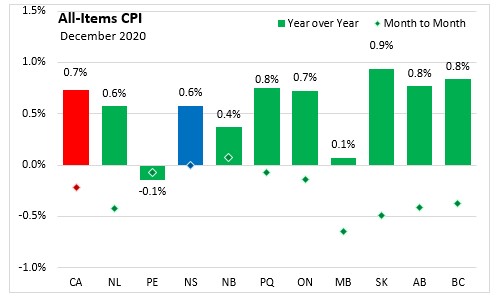
Nova Scotia's consumer price inflation (year over year growth in CPI) excluding food and energy rose 1.5% in December higher than the national rate of 1.1% and the highest among all provinces. Manitoba (-0.1%) was the only province registering a price level decline for this index in December. On a monthly basis, Nova Scotia's index excluding food and energy was down 0.4 per cent.
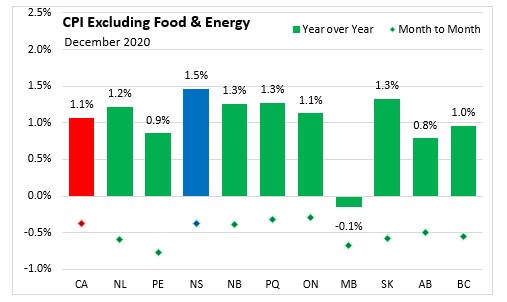
The main contributors to the monthly (December 2020 vs. November 2020) NS CPI movement:
- Gasoline (+5.9%)
- Fuel oil and other fuels (+7.7%)
- Women’s clothing (-10.2%)
- Men’s clothing (-8.7%)
The main contributors to the annual (December 2020 vs. November 2019) NS CPI movement
- Homeowners’ replacement cost (+8.7%)
- Passenger vehicle and insurance premiums (+8.8%)
- Gasoline (-14.0%)
- Fuel oil and other fuels (-17.6%)
The CPI for food in Nova Scotia 1.9% year-over-year with a 0.2% decrease month-to-month in December 2020. CPI growth in food (year over year) was up in all provinces this month. Prince Edward Island (+3.2%) showed the highest year over year food price growth. Nationally, food prices increased 1.1%.

The Nova Scotia energy price index declined 9.7% year-over-year in December 2020, higher than the national average of 4.0%. Prince Edward Island posted the largest percentage decline at 12.2% in December. Monthly energy prices increased 3.9% in Nova Scotia, and 1.9% in Canada.
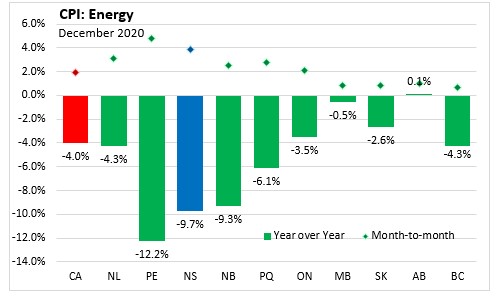
Year over year, the consumer price index for shelter increased by 0.3% in Nova Scotia, lower than the national average (+1.6%). Shelter prices were up in every province except Prince Edward Island (-1.7%) and Newfoundland and Labrador (-0.1%).
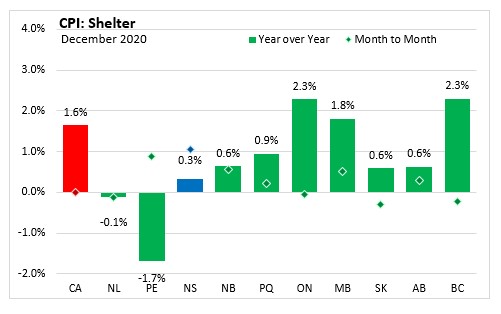
Nova Scotia's year-over-yearconsumer price inflation excluding energy was 1.6% in December compared to a national rate of 1.1%. This was also the highest increase among all provinces. The lowest gain was registered in Manitoba (+0.1%).
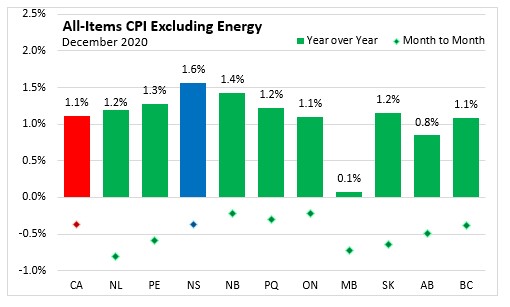
Long Run Trends
Nova Scotia's annual inflation has mostly been below the Canadian average since mid-2014, with the exception of only a few months. While month to month movements in the indices can be different, over time they generally follow the same overall trend.
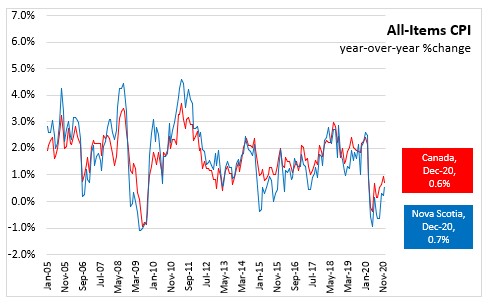
Excluding food and energy prices, Nova Scotia's inflation is typically closer to the national average.

Bank of Canada's preferred measures of core inflation
Compared with December 2019, CPI-Common increased 1.3%, CPI-Median rose 1.8% and CPI-Trim was up 1.6% in Canada. All-items CPI excluding eight of the most volatile components as defined by the Bank of Canada and excluding the effect of changes in indirect taxes (formerly referred to as CPIX), rose 1.5% year over year.
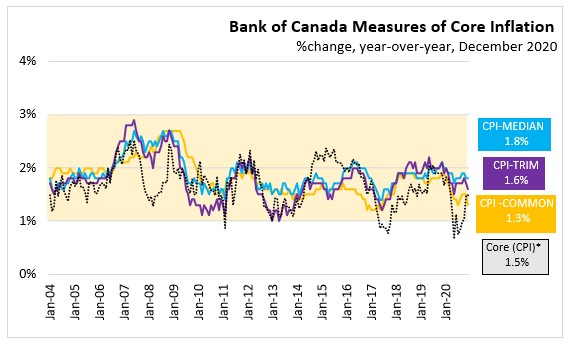
Appendix Tables and Charts

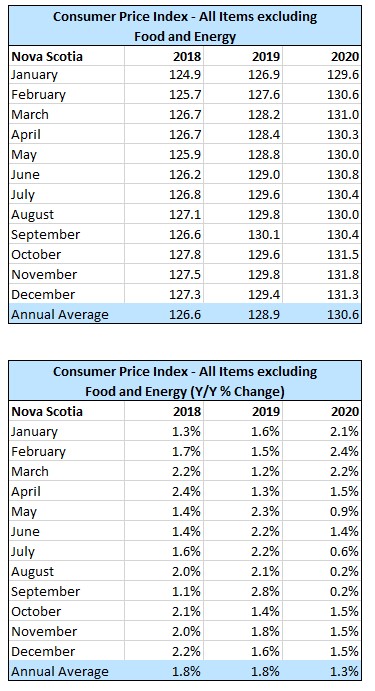
Source: Statistics Canada data portal: Tables 18-10-0004-01 and 18-10-0256-01
<--- Return to Archive